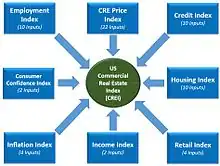For another index with a similar name, see SIOR Commercial Real Estate Index ("CREI")
The US Commercial Real Estate Index ("CREI") is designed to demonstrate the relative strength of the US Commercial Real Estate market.
Created in 2014, the US CREI was created by CRE Demographics, LLC, and examines eight economic drivers in order to determine relative market strength.[1]
The economic drivers behind the CREI are isolated into sub-indices that include the Employment Index, Commercial Real Estate Price Index, Credit Index, Consumer Confidence Index, Housing Index, Inflation Index, Income Index, and the Retail Index.

In total, there are over 60 inputs in the US Commercial Real Estate Index all of which come from publicly released data. Most of these come from public sources that are listed below.
- ADP
- Bureau of Economic Analysis (BEA)
- The Conference Board
- Federal Housing Finance Authority (FHFA)
- Federal Reserve
- Mortgage Bankers Association
- Mortgage Market Survey
- National Association of Real Estate Investment Trusts (NAREIT)
- National Association of Realtors (NAR)
- New York Stock Exchange
- University of Michigan
- United States Census Bureau
- United States Department of Labor
- United States Treasury
References
- ↑ "Commercial Real Estate Price Index in Commercial Real Estate". Commercial Real Estate Loans. Retrieved 2023-11-02.